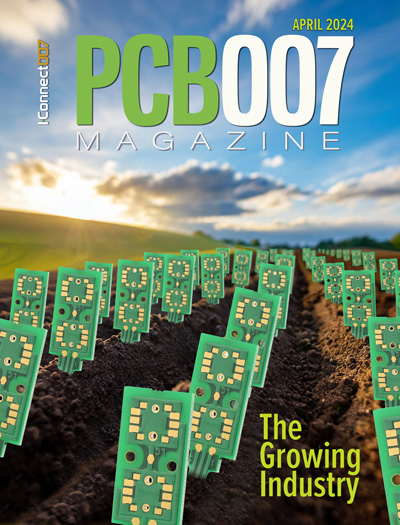-

- News
- Books
Featured Books
- pcb007 Magazine
Latest Issues
Current Issue
The Growing Industry
In this issue of PCB007 Magazine, we talk with leading economic experts, advocacy specialists in Washington, D.C., and PCB company leadership to get a well-rounded picture of what’s happening in the industry today. Don’t miss it.

The Sustainability Issue
Sustainability is one of the most widely used terms in business today, especially for electronics and manufacturing but what does it mean to you? We explore the environmental, business, and economic impacts.

The Fabricator’s Guide to IPC APEX EXPO
This issue previews many of the important events taking place at this year's show and highlights some changes and opportunities. So, buckle up. We are counting down to IPC APEX EXPO 2024.
- Articles
Article Highlights
- Columns
Search Console
- Links
- Events
||| MENU - pcb007 Magazine
HDP User Group 2017 European Meeting Highlights Technology Progress
June 7, 2017 | Pete Starkey, I-Connect007Estimated reading time: 18 minutes
The splendid conference facility at the offices of Oracle, in the royal burgh of Linlithgow in West Lothian, Scotland, was the venue for the 2017 European meeting of the High Density Packaging User Group, the project-oriented consortium whose mission is to reduce costs and risks for the electronics industries by improving cooperation between system integrators, contract assembly manufacturers and suppliers in the high-density packaging development and design process, using member resources in a domain where members can gain much more by joint activities than by duplicating work in individual member companies. I was delighted and privileged to be invited once again to sit in on the open session, an intense programme of technical presentations and discussions, project reviews, status updates and new project proposals, mostly delivered in person, some from afar by WebEx link, plus two thought-provoking guest presentations.
Participants were welcomed and invited to introduce themselves by Executive Director Marshall Andrews, who then thanked Oracle for kindly hosting the meeting before handing over to Maurice Smith of Oracle who gave an interesting address about the history and current use of the landmark Linlithgow campus. Smith explained that the site was originally built with the assistance of Scottish Enterprise as part of “Silicon Glen” and was the first SUN manufacturing operation to be built outside the USA and employed 1500. He went on to describe the transition of the site as part of SUN’s global infrastructure through to engineering solutions for telecoms companies wishing to embed SUN technologies. Following the integration into Oracle in 2010 Smith described the further transition into customer-focused infrastructure incorporating five secure modular data centres each integrating multiple power and network paths.
Andrews presented Smith with a plaque acknowledging their support of HDP User Group.
The meeting was then handed over to Project Facilitator Bev Christian to moderate the project review session. Beginning with high-frequency topics, Christian himself reviewed progress on the RF Failure Detection project, which was at the definition phase. It had been observed that failure in RF circuits could occur because of mechanical changes which affected return loss, well before the incidence of complete solder joint failure, and that RF measurements of signal paths were more sensitive than standard resistance measurements to incipient conductor or solder joint failure. The project set out to determine whether RF measurement of signal loss at different frequencies could be a useful technique for the early detection of partial cracking in solder joints, long before catastrophic failure occurred. This would benefit those industry sectors concerned with high speed data and voice communications, and could possibly put a new interpretation on the term “failed solder joint” and offer an explanation for many “no-fault-found” field returns. He discussed the details of test vehicle design, materials and components, and the proposed experimental plan for thermally stressing the assembly whilst making comparative DC and RF measurements. The objective was to deliver a method that would allow the detection of changes in solder joints significant enough to affect RF circuit performance that might not necessarily be detected by conventional means.
High-speed signal integrity has become an issue of increasing significance and the effects of copper surface roughness on insertion loss have been extensively studied and reported. But a curious observation to come out of the recently completed HDP User Group Smooth Copper Signal Integrity project was the apparent difference in X-axis versus Y-axis roughness on the drum side of the copper foil after certain bonding treatments, resulting in different degrees of insertion loss. This had led to the High-Frequency Loss from Copper Topology project, currently in its definition phase, and reported by Oracle’s interconnect specialist Mike Freda. Established modelling methods did not take this loss effect into account and there was no quantitative data in the literature, so the project set out to reproduce the results of Smooth Copper SI project and to investigate and measure the effect of this apparent copper directionality on insertion loss. Questions to be answered were whether this observed directionality was due to the copper foil manufacturing process or the chemical cleaning and bonding treatments used during innerlayer fabrication, how it responded to different test methods for measuring losses and to what extent loss models were affected.
The topic changed to emerging technologies, with the first presentation given by Yoshi Hiroshima from Fujitsu via WebEx link from Japan, reporting on the project studying the influence of hole-wall roughness on creep fatigue in plated-through holes, which was at the idea stage. The prediction of PTH lifetime had been the subject of previous studies, but the calculation had been found to be valid only for very high levels of strain. At lower levels, the strain was mainly creep strain which did not obey the Manson-Coffin rule for fatigue-crack growth. The current project aimed to establish an accelerated equation to predict PTH lifetime and provide a better understanding of creep strain and the influence of copper plating roughness, using finite-element simulation verified by high-temperature testing. Once the typical creep characteristics had been identified and quantified, the PTH lifetime predictor equation could be augmented and its accuracy enhanced.
Continuing the emerging technologies theme, HDP User Group facilitator Jack Fisher described the Military Halogen-Free Laminate Evaluation project which was at the idea phase, the call for participation having gone out about six weeks previously. Numerous halogen-free and low-halogen laminate projects had been conducted in the past by consortia such as iNEMI and HDP User Group, but their focus had been on consumer electronics applications, and they had not addressed the reliability requirements for the military and aerospace industries. The objective of this project was to evaluate the best possible low-halogen laminates for mil/aero applications against known reliability requirements. For the OEM, the benefits would be access to a database comparing the performance of various halogen-free laminates tested to current mil/aero qualification standards, to enable designers to select the best materials for specific harsh environment, high-reliability product requirements. Material suppliers would have the opportunity to showcase their materials, measure them against competitors’ materials and to identify product strengths and weaknesses against mil/aero requirements with a focus on lead-free assembly. He discussed typical test requirements with reference to the iNEMI 2017 roadmap, and proposed test vehicle design rules and a possible test program format. The primary project deliverable would be a report to include all empirical data with analysis, conclusions and recommendations for future work. There was some discussion as to whether the military actually wanted or needed low- or no-halogen materials and the term “military” covered a very wide range of applications, with no single group responsible for defining its requirements. But the point was made that polyimide, on which the military had depended for the last generation, might be too hygroscopic for future HDI designs, and it had limitations in high-speed signal-integrity applications. So there was plenty of scope for open-minded thinking now that a wide range of thermally stable alternative materials was available.
Mike Freda returned with an update on DISC 2, the second phase of the Digital Image Speckle Correlation project. Digital image speckle correlation is a non-contact optical technique for quantitative measurement of deformation and strain, and the project was a physics-based study to determine whether it could be used to predict the differences in reliability behaviour of the stacked microvia constructions observed in the HDP User Group Multilam project. The Multilam test vehicle designs had included combinations of microvias at various pitches and various stack heights, and either stacked on top of buried vias, or offset from them. The results of Phase 1 of the DISC project had been consistent with the Multilam IST test results, which had indicated that the all-on-buried-via designs were markedly less reliable than the off-buried-via constructions. The DISC experiments had demonstrated that in the on-stack designs, the highest shear strain corresponded to the location of failure in actual tested samples, whereas for the off-stack designs there was no evidence of shear strain; instead, a large rotational moment was observed between the structures and the trace between the vias was taking the strain and preventing failures. Phase 2 was planned to start in July 2017, and would expand the scope of test vehicle design to include 2-4 stacks on 12, 18 and 24 layer constructions on two different laminate materials. This would establish additional empirical data which could be used to compare with the data from available FEM tools.
The first guest presentation came from Martyn Gaudion, managing director at Polar Instruments, and was especially relevant to the earlier discussion of the High-Frequency Loss from Copper Topology project, since it was specifically concerned with the significance of copper roughness in modelling and calculating insertion loss. Gaudion commented that during his 25 years at Polar, the company had progressed from supplying signal integrity tools for PCB fabricators to providing modelling tools for the design community, and continued to smooth the passage between PCB design and fabrication. He put a perspective on his explanation of insertion loss modelling with a quote from George Edward Pelham Box, the distinguished British statistician: “All models are wrong, but some are useful!” before describing how copper roughness could be quantified as a parameter in a transmission-line field solver. The surface of a copper conductor had a major influence on the way a high-frequency signal was carried, because of the tendency for the current to be concentrated in the outer skin. This “skin effect” became increasingly predominant as frequencies increased beyond the 10MHz level, and the rougher the copper surface the greater the insertion loss.
Page 1 of 2
Suggested Items
Taiyo Circuit Automation Installs New DP3500 into Fuba Printed Circuits, Tunisia
04/25/2024 | Taiyo Circuit AutomationTaiyo Circuit Automation is proud to be partnered with Fuba Printed Circuits, Tunisia part of the OneTech Group of companies, a leading printed circuit board manufacturer based out of Bizerte, Tunisia, on their first installation of Taiyo Circuit Automation DP3500 coater.
Vicor Power Orders Hentec Industries/RPS Automation Pulsar Solderability Testing System
04/24/2024 | Hentec Industries/RPS AutomationHentec Industries/RPS Automation, a leading manufacturer of selective soldering, lead tinning and solderability test equipment, is pleased to announce that Vicor Power has finalized the purchase of a Pulsar solderability testing system.
AIM Solder’s Dillon Zhu to Present on Ultraminiature Soldering at SMTA China East
04/22/2024 | AIMAIM Solder, a leading global manufacturer of solder assembly materials for the electronics industry, is pleased to announce that Dillon Zhu will present on the topic: Ultraminiature Soldering: Techniques, Technologies, and Standards at SMTA China East. This event is being held at the Shanghai World Expo Exhibition & Convention Center from April 24-25.
AIM to Highlight NC259FPA Ultrafine No Clean Solder Paste at SMTA Wisconsin Expo & Tech Forum
04/18/2024 | AIMAIM Solder, a leading global manufacturer of solder assembly materials for the electronics industry, is pleased to announce its participation in the upcoming SMTA Wisconsin Expo & Tech Forum taking place on May 7 at the Four Points by Sheraton | Milwaukee Airport, in Milwaukee, Wisconsin.
Hentec/RPS Publishes an Essential Guide to Selective Soldering Processing Tech Paper
04/17/2024 | Hentec Industries/RPS AutomationHentec Industries/RPS Automation, a leading manufacturer of selective soldering, lead tinning and solderability test equipment, announces that it has published a technical paper describing the critical process parameters that need to be optimized to ensure optimal results and guarantee the utmost in end-product quality.


